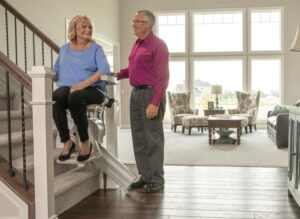

Living with someone who uses a wheelchair can seem like a challenge, but with proper preparations and precautions you will find that living with someone who uses a wheelchair to not be as big of a deal as you initially thought. There are a number of ways you can make your home safer for your wheelchair and mobility limited family members, and it starts with the main entrance to the home.
When making your home safer for a wheelchair user the two biggest struggles are stairs and entryways. The main entrance to your home should have a wheelchair ramp to get up the stairs and often times a threshold ramp to get over the bump of a doorway.
Once a wheelchair user gets into the home, there are still upgrades and additions you can make to your home to help it be safer and more accessible to their mobility needs.
If you do not live in a single-story home or ranch-style house, a stairlift will be the next addition you need to consider for your home. Stair lifts come in a variety of weight capacities and options depending on your staircase. If your staircase is curved, you will need a custom stairlift, however straight staircases can normally be fitting with a standard and in-stock option that may be available for a next day install.
Residential vertical platform lifts help you to gain access to your porch, outdoor deck or even from floor to floor insider the home. They are quiet, safe and serve as a smooth method of transportation without the need to get out of your wheelchair, power chair or scooter.
One of the most overlooked changes to the home when adapting it to be wheelchair friendly are the doorways. Resizing doorways, while considered a large project, are essential for wheelchair users to navigate safely through the home with ease. Unfortunately, residential doorways are normally measured to be between about 23 to 27 inches, which is too narrow for a wheelchair to fit through. The width required for ADA compliancy is 36 inches, and while these rules are not required to be followed in residential areas, they are good guidelines for resizing doorways and entryways in the home too. Widening doorways can be done through remodeling, but keep in mind other changes that including wiring changes may be necessary for moving light switches and power outlets. A temporary fix for widening doorways is to remove the door unit and doorway trim until a professional can come in to properly resize the doorway.
Don’t forget lifts and rails in areas of transition such as bathrooms and showers as well as beds. Installing ways someone to move from their wheelchair to the toilet or their wheelchair to their bed without assistance is a very important aspect of living with someone who uses a wheelchair. Doing all you can to help them keep their independence can increase confidence, happiness and even help them live longer.
A very significant change you can do to make your home safer for a wheelchair rider has little to do with stair lifts, vertical platform lifts (VPLs) or ramps, it has to with tripping hazards and obstacles in the home.
To make your home safe for wheelchair users you need to be cognizant of your surroundings at all times and ensure that walkways, entryways and paths routine taken are clear of clutter, pets and other tripping hazards. Rugs, power cords, pets and clutter are among the most common tripping hazards in the home. For wheelchair users, tripping hazards become more like obstacles on their path to their destination and certain obstacles may get tangled in motorized chairs, scooters and wheelchairs. This can damage your mobility unit or cause mechanics within it to malfunction.
You should also consider modes of transportation as a safety concern for your wheelchair bound loved ones. Owning an accessible van can make all the difference in the world when making your wheelchair bound family members feel included. There are two types of handicap accessible vans, side entry and rear entry. Both styles can use a ramp entry or lift entry method, however the difference in the model you need will be based on your passenger count.
A rear entry van’s biggest advantage is the ground clearance and being able to park in any parking spot. The rear entry vans limit the space for passengers to only be 4 seats and space for a wheelchair.
The side entry handicap vans allow for up to five passengers and one wheelchair and even allow for the wheelchair user to drive from their wheelchair or sit in the front passenger seat area.
If your loved one has a motorized chair or scooter then a wheelchair accessible van may not be necessary and a car lift will suffice. There are three basic types of chair lifts; inside hoist lifts, outside automatic lifts and hybrid inside/outside lifts. The inside hoist lift will hoist, lift and load the mobility unit into the vehicle and the outside automatic lift works off an actuator and platform to carry a wheelchair, scooter or motorized chair on the rear exterior of the vehicle. A hybrid lift allows for your mobility device to be loaded onto the platform on the ground then hoisted and loaded into the interior of the vehicle.
From ramps, to stairlifts, to vans, VPLs and car lifts, ensuring your home is safe, equipped and laid out for a wheelchair bound family member is the key to making them feel at home.

Click the link to view our available vans!
To help with the journey of independence. We have become an industry mobility leader from wheelchair ramps, stairlifts, mobile scooters, vertical platform lifts, scooter lifts and so many more products, we have for.
